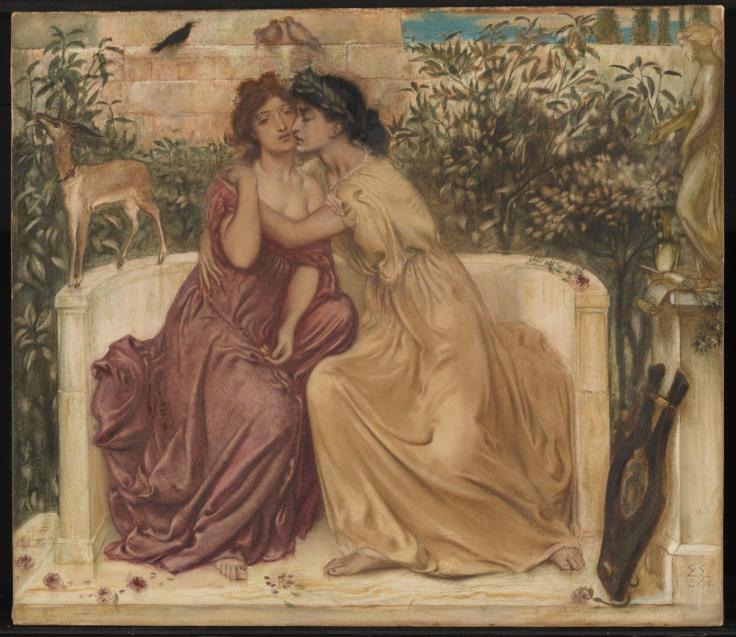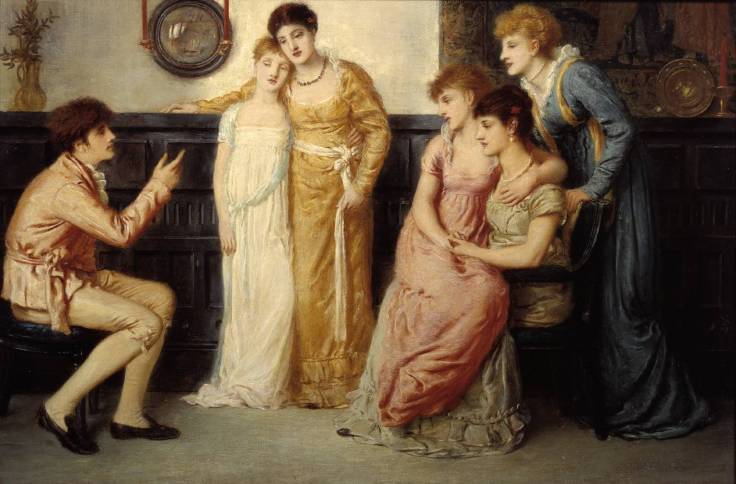The upper image presents a common idea of sexuality in the Victorian era. The painting depicts a man, who punished his wife for adultery. The image tried to teach the public a lesson. [1] This painting is a good example of what Foucault discussed in his book The history of Sexuality. The picture showed a dominant discourse about sexuality during this period, which the public could understand, because they thought in line with the same discourse. At the same time, the public looking at the painting today, can say how women were repressed during this period.
Foucault has written The history of Sexuality during the period of liberation movements in France, during which people stated how they got sexually liberated. Foucault replied to this by asking himself the following question: “Why do we say, with so much passion and so much resentment against our most recent past, against our present, and against ourselves, that we are repressed?” [2] According to him, people didn’t got liberated, but lived in another discourse than the dominant discourse in the Victorian era. Since people still lived in a discourse, they were not more liberated than former times. [3] My aim in this blogpost, is to declare thise statement.
According to Foucault, the idea of repression was a cultural constructed discourse, which only existed, because it’s existence in the minds of people. [4] Whereas in premodern times, power was practised by one sovereign, in modern times, power got practised in invisible power structures. [5] Two of these power structures were “science” and the theory of Freud. [6] Scientific evidence was used to proof statements about sexuality, although the evidence was also constructed in a certain discourse. There was also a political and historical discourse about the repression of sexuality, saying that repression originated in the seventeenth century and with the development of capitalism.
A third power structure was formed by people discussing sex, which Foucault called the speaker’s benefit. In these discussions, people were making statements in line with the discourse. By this, the individual established the repressed discourse. Therefore, during the Victorian period, people were not repressed because of laws, but made themselves repressed. Foucault called this the disciplinary power. [7] The power structures were produced and sustained by people with the use of science and the speaker’s benefit. [8]
Thus Foucault concluded that sexuality in the Victorian era was not repressed, but rather regulated through a dominant discourse, which people discussed in their daily lives. Moreover, the idea of sexuality was used as an instrument for nation-building. Nead describes this in her analysis as well. In her studies, she uses Foucault to analyze Victorian paintings. According to her, different images about gender and class differences, as well as ideas about sexuality were produced in order to built up an “English national identity.”[9] Moreover, Nead argues that the gender differences were not seen as repressive, but as natural differences between men and women. [10] This would then mean, that the heading image, made by Augustus Leopold Egg in 1858, was not seen as a form of repression, but as normal.
The discourse analysis of Foucault could be seen in Victorian paintings as well. [11] A good example is the painting of Simeon Solomon called “Sappho and Erinna in a garden at Mytilene“, made in 1864. This image depicts Sappho, who wrote letters to Aphrodite in the 4th century B.C., begging her to help her with her romantic feelings for other women. Solomon was a widely appreciated painter and because of the depiction of two women, the public did not see is as a scandal, but rather as a sensual piece of art. [12]

The same can be seen in another painting of Solomon. In “A youth relating tales to ladies” made in 1870, subtle notions of same sex relationships can be seen in the gestures of the women. This painting was again much appreciated which shows how in the victorian discourse, sexual feelings between two women were not seen as abnormal, but as sensual.
These two paintings show how there was much interest in sexual relationships. It is important to note that Solomon got arrested in 1873 for having homosexual relationships in public. After his release, he was not successful as a painter anymore and became a homeless man. [13] The fact that Solomon couldn’t sell paintings, proves how sexual aspects as homosexuality, were seen as abnormal, not by laws, but by the disciplinary power.
Funny fact is, how the Tate museum describes the story of Solomon on their website. They are concluding their article with the following words: “When he was released from prison he was rejected by many of his aquaintances, struggled to find work and soon became homeless; a painful reminder of our repressive past.” [14] Thinking in line with Foucault, this is a false statement, because we still live in a dominant discourse about sexuality with it’s own norms and power structures. The only thing that did change, is the discourse itself. We should therefore rethink our notions about the repressed Victorian era and be aware of the fact that if we talk about the repression of sexuality and our liberation today, as the Tate museum does, we still think in terms of a dominant discourse.

Notes
[1]: The painting is the first part of three. In the other paintings, the effects of the adultery are showed. The second painting shows the two daughters as orphans and the third painting shows the mother as homeless. See: Frances Fowle, ‘Past and present no.2’ (version 4th December 2017) http://www.tate.org.uk/art/artworks/egg-past-and-present-no-2-n03279 1 December 2000.
[2]: Michel Foucault, The history of sexuality. Volume 1. An Introduction (New York, 1978) 8,9.
[3]: Ibidem, 7.
[4]: Ibidem, 10
[5]: Ibidem, 11.
[6]: Gillian Rose, Visual Methodologies: An introduction to researching with visual materials (London 2016), 190
[7]: Foucault, The history of sexuality, 6
[8]: Ibidem, 6.
[9]: Lynda Nead, Myths of sexuality. Representations of women in Victorian Britain (Oxford, 1988) 43.
[10]: Ibidem, 29.
[11]: According to Nead, Art can be understood as a discourse. See: Rose, Visual Methodologies 187.
[12]: Tate museum of modern art, ‘Five stories of queer artists’ (version 4th December 2017) http://www.tate.org.uk/art/long-read/five-stories-queer-artists.
[13]: Ibidem.

I liked the way you introduced the topic or your “research question” with a painting which relates to it. Thus, it was a good start into your topic, which grabs the reader’s attention and is well explained. Furthermore, I thought that your examples or to be exact the painting were very suitable and interesting for the chosen topic and you embedded them well into your blog post. However, I think you could do something about the length of your paragraphs, especially the second one, since they were quite long and therefore it was at times hard to stay focused while reading.
LikeLike